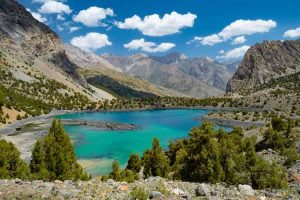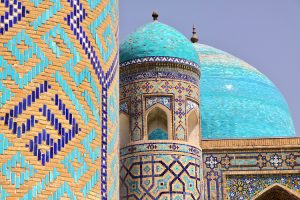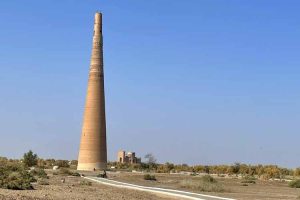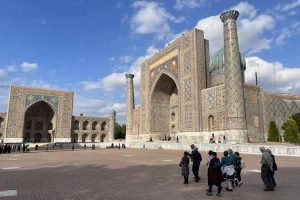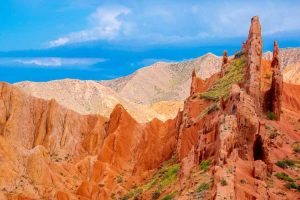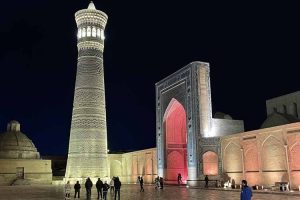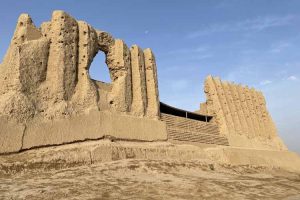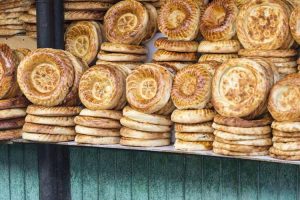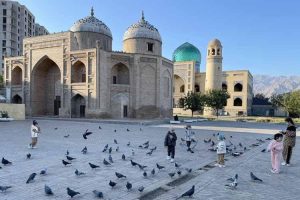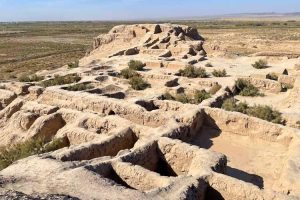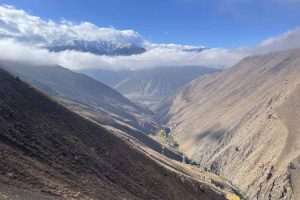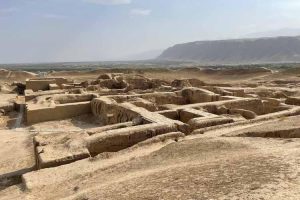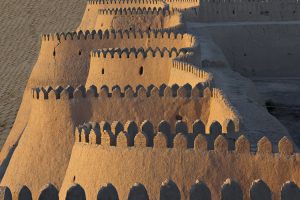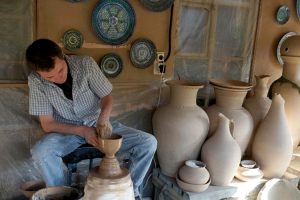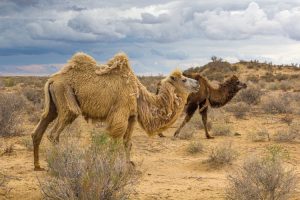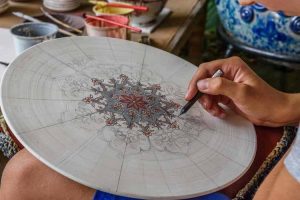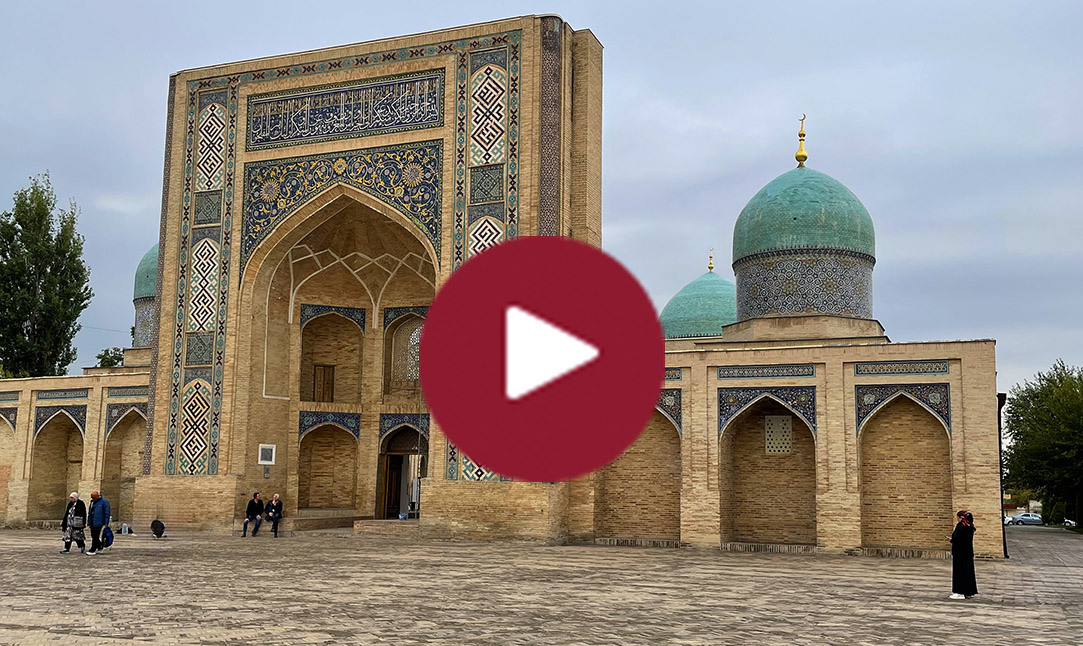Kyrgyzstan, Uzbekistan | Tours
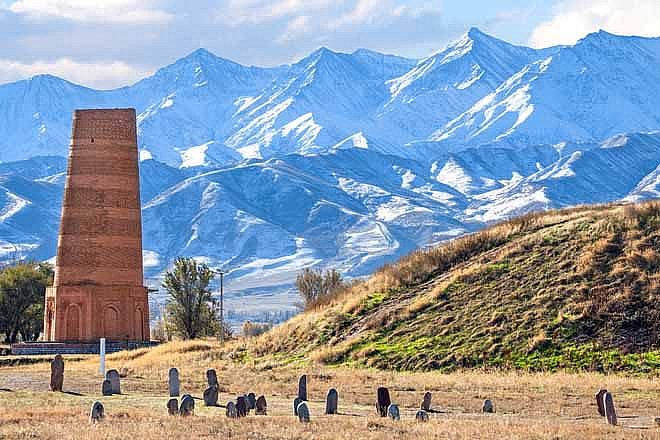
- Duration: 25 days from the UK
- Private Departures Available
Flight inclusive from £6490, Land only from £5750
Explore the remarkable cities of the Silk Road, discover mountains, deserts and natural wonders, and uncover the rich cultural heritage that defines this vast yet little-known region of Asia.
Highlights
- Discover the splendours of the ancient Silk Road cities
- Explore ruined desert cities in the desert and important archaeological sites
- See natural wonders such as the Charyn Canyon and the ‘Gates of Hell’
- Enjoy the splendid scenery of the Fann Mountains
- Learn about the many artisan crafts of the region
- Try your hand at yurt building and archery
- Take in the modern-day highlights of Tashkent and Ashgabat
- Travel throughout with a Tour Leader plus local expert guides
Reviews
This epic journey follows the trade routes that once criss-crossed the heart of Central Asia, revealing untold natural wonders, timeless cultural traditions and ancient buildings that have stood for millennia.
The Five Stans of Uzbekistan, Turkmenistan, Tajikistan, Kyrgyzstan and Kazakhstan cover an area greater than the size of Western Europe and form an immense region of unbelievable contrasts and diverse landscapes. They range from the vast deserts of Karakym and Kyzlkum to the rolling steppes and red-rock canyons of Kazakhstan, and from the towering mountains of the Tien Shan to the fiery chasm of the Gates of Hell in Turkmenistan.
Along with the superlative scenery you will discover incredible architectural and historic sights. Highlights include the breathtaking, blue-tiled mosques, madrasahs and mausoleums of the great Silk Road cities, and the crumbling ruins of the once great desert citadel of Merv. Along with these impressive remains of bygone times you’ll see vibrant modern-day metropolises and the grandiose legacies of the former Soviet era.
As you travel across the Stans you will also experience the wonderfully rich cultural heritage of the region. This can be evidenced in the exquisite craftsmanship that has been passed down through the generations, ancient skills such as eagle hunting that are still practised, and the nomadic way of life that many still live. You will take tea with locals, visit artisan workshops, explore bazaars and even try your hand at yurt building and archery.
Throughout the journey you will be looked after by an experienced tour leader, ably assisted by expert local guides to really get you under the skin of the place you’re visiting. Accommodation is in comfy hotels, family-run guest houses and even a yurt camp, all of which have been carefully selected for their comfort, character and good locations.
All in all, this is a superb exploration of a vast, varied and utterly enthralling region of the world.
Private Departures
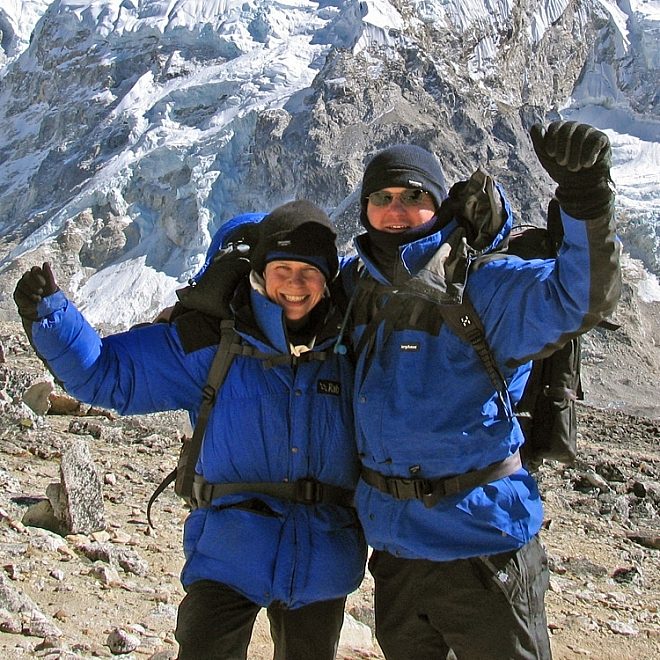
The Five Stans Tour of Central Asia - Private Departures
If you would prefer to travel just with your partner, friends or family, we can arrange a private departure of this holiday. You follow the same itinerary, but travel on dates that suit you. Alternatively we can include elements of this holiday in a bespoke Tailor Made itinerary. Contact our friendly team for details and prices, and to make a booking.
At a glance
Duration: 25 days from the UK
Max. Altitude: 2,400m/7,875ft, Seven Lakes, Day 16
Private Departures Available
Guaranteed to run for a minimum of 4 clients
Maximum group size: 12
Accommodation types: Hotels, guest houses, yurt camp (1 night)
Meal arrangements: 24 x breakfasts, 21 x lunches, 21 x dinners. All meals except lunches and dinners on days 6 and 14 which are free for your own exploration.
Itinerary overview
| Day | Activity |
|---|---|
| 1-2 | Fly to Tashkent in Uzbekistan. Guided walking tour. Time at leisure. |
| 3 | Fly to Nukus. Drive to Khiva. Visit Savitsky Museum and Mizdakhan Necropolis |
| 4-6 | Drive to Khiva with visit to Chipkyk Kala. Tour of Khiva and sunset visit. Free day in Khiva. |
| 7 | Cross to Turkmenistan.Drive across the Karakum Desert to Darvaza. Visit ‘Door to Hell’. |
| 8 | Drive to Ashgabat and city tour. |
| 9 | Fly to Mary and visit ruins at Merv. |
| 10-11 | Cross back into Uzbekistan and drive to Bukhara. Tour of Bukhara. |
| 12-14 | Visit craft workshops in Bukhara and train to Samarkand. City tour and free day. |
| 15-16 | Cross into Tajikstan and drive to Panjakent. Visit Sarazm. Day trip to Fann Mountains. |
| 17 | Drive to Khujand and city tour. |
| 18 | Cross into Uzbekistan and drive to Kokand with sightseeing. Drive to Rishtan and visit Rustam Usmanov. Drive to Fergana. |
| 19 | Cross into Kyrgystan and drive to Osh. Tour of Osh and fly to Bishkek |
| 20-21 | Drive to Balasagun and visit Burana tower, continue to Kochkor village. Visit felt workshop. Drive to Issyk-Kul Lake, Kyzyl-tuu village and Bokonbaevo. Eagle hunting demonstration. |
| 22 | Drive to Karakol with visit to Skazka Canyon and Jety-Oguz Gorge. |
| 23-24 | Cross border into Kazakhstan and visit Charyn Canyon. Drive to Almaty. Day trip to Ethno Aul, a replica of a traditional Kazakh Village. |
| 25 | Fly to London. |
Holiday Itinerary
Day 1 - Fly London To Tashkent
Depart London on an overnight flight to Tashkent.

Day 2 - Arrive Tashkent. Transfer to hotel. Afternoon city tour.
You will land in Tashkent in the early morning and on arrival you will be welcomed by your Tour Leader and transferred to your hotel. You will check in and have breakfast and then have a few hours rest after your long flight.
Later you will meet for lunch at a local restaurant and in the afternoon you will have a city tour. Tashkent is the capital of Uzbekistan and claims to be the most cosmopolitan city of Central Asia. Although it has been continuously inhabited for over 2,000 years, a massive earthquake in the 1960s levelled most of the city and a modern city was born. The city is noted for its tree lined streets, numerous fountains and pleasant parks. On your tour you will visit the Khast-Imam complex - Khast Imam is the religious centre for Muslims in Central Asia and includes the Barak Khan Madrasah (16th century), Tilla Shaykh Mosque (the Osman Koran, believed to be world's oldest Koran, is kept in the library of this mosque) and the mausoleum of Abu Bakr Kaffal Shoshi (a 13-14th century Islamic scholar). You will also visit the Chorsu Bazaar – this huge and busy bazaar, the largest in Tashkent, is set beneath a magnificent dome decorated in traditional Uzbek style with blue tiles. A vast variety of goods are sold here and a visit here is a great introduction to daily life in Uzbekistan.
You will also take a ride on the famous Tashkent Metro. The metro was built between 1966 and 1977, and was the first metro in Central Asia. The subway stations (especially those of the first two lines built) are very beautiful and are famed for their amazing architecture. Platforms are richly decorated with glazed columns, bas reliefs, stucco and enamel, chandeliers and original art. For dinner you will be taken to a themed restaurant and perhaps have your first taste of Uzbekistan’s famous national dish, ‘plov’, a traditional dish of Central Asia which you will encounter throughout your travels through the Five Stans.

Day 3 - Fly to Nukus - 1 hour 40 minutes. Visit Savitsky Museum of Art and Mizdakhan Necropolis.
This morning you will take the early flight to Nukus, an isolated, rather nondescript city, located in the valley of the Amu Darya River.
Nukus’s main claim to fame is as home to the Savitsky Museum, a museum which has been called the ‘lost Louvre of Uzbekistan’ and a “museum of forbidden art”. It has one of the most remarkable collections of dissident and Avant Garde Soviet art anywhere. You will have a guided tour of the museum, which houses some 90,000 artefacts and art works, including many works by 20th century Russian painters, much of it collected and brought here by Igor Savitsky. Savitsky was a renegade artist from Moscow who, during the Soviet era, found sanctuary from the authorities in this isolated backwater and started to collect art works. There are works in the collection of both Russian and Uzbek artists who worked after the 1930s, when all work that wasn’t ‘socialist realism’ was banned by Stalin. Savitsky brought together this impressive collection, of which only a small percentage is on show, and the museum was created under his guidance in 1966 and he was its first curator. It also houses an impressive collection of archaeological objects and folk art.
In the afternoon you will visit the nearby remains of ancient Mizdakhan, about half an hour from the centre of Nukus. Mizdakhan is one of the oldest and most visited pilgrimage sites of the region. Local legend says this is where Adam was buried, which may account for its sacred status in ancient times. The city of Mizdakhan was founded in the 4th century BC and inhabited right up until the 14th century AD when it was destroyed by Timur (Tamerlane), the Turko-Mongol leader who conquered most of Central Asia. After its destruction the city was depopulated but it remained a sacred place even after this, although as a ‘city of the dead’ it was solely a necropolis and burial place. Tombs and mosques were still being built here right up to the 20th century. It is an atmospheric place, though rather windswept and lonely. After your visit you will return to Nukus for dinner.

Day 4 - Drive to Khiva - 220 km, approximately 7 hours. Explore fortresses of the Kyzylkum Desert.
Today you will drive to Khiva, crossing the vast Kyzylkum Desert, which lies between the two great rivers, the Syr Darya and the Amu Darya. (The Oxus River of ancient times).The Kyzylkum Desert (in Turkic meaning ‘red sand’ although it mostly isn’t!) is one of the most extensive deserts in Asia. The crossing of this desert was an important stage on the Great Silk Road - Alexander the Great, Genghis Khan and Tamerlane all passed through here, as did British and Russian spies in the 19th century, often disguised as holy men and horse traders, during the secret stratagems of the ‘Great Game’, when Russia and England were vying for Influence in the region.
Your first visit of the day will be to Chilpik Kala, just 40 km from Nukus. This great circular structure on a hill top, was originally a Zoroastrian burial place or ‘Tower of Silence’. In Zoroastrianism, once the dominant religion in Persia, towers such as Chilpik Kala were an important element in their burial rituals. In such towers the bodies of the dead were exposed to the elements so that with the effect of the sun and birds (usually vultures) they could be disposed of naturally. The impressive tower at Chilpik Kala is thought to have been built over 2,000 years ago. From the top of the ruins there are excellent views over the surrounding country and to the River Amu Darya.
From Chilpik Kala you continue your journey across the desert, following the route of ancient caravans, and visiting further ancient fortresses which once guarded the way along the Silk Road. You should arrive in Khiva by the early evening.

Day 5 - In Khiva with sightseeing.
Khiva is an ancient city of the Great Silk Road, once famous as a slave trading post. Nowadays the well preserved city centre is a delightful labyrinth of narrow mud-walled alleyways and spectacular blue mosaics that will transport you back in time. In the morning you will have a tour of the magnificent Ichan Kala architectural complex, built over the 12th to 19th centuries. Now a UNESCO World Heritage site it was the site of the residence of the last Khan and of high officials, clergy and rich merchants. The complex includes the Ismail Khodja Mausoleum, Mohammed Amin Khan Madrassa, Kunya-Ark Castle (16-17th century), Kalta Minor Tower, Tash-Hovli Palace (19th century), Pahlavan Mahmud Mausoleum (14-18th century), and the Juma Mosque (10th century).
Later you will visit a ceramic workshop. The ceramics of Khiva are famous and the making of ceramics is one of the most respected traditional crafts in Uzbekistan, with time-honoured techniques being passed on from generation to generation.
After lunch you will have time free for your own exploration or for shopping.
In the late afternoon you will meet your Tour Leader to go to the Ark Watch Tower to enjoy a wonderful sunset over the city from the roof of the tower, from where there are all round panoramic views over Ichan Kala and the mosques, minarets and city walls of Khiva.

Day 6 - Day at leisure in Khiva. Navruz festivities in the spring.
On our autumn departure you will have a full day to explore Khiva further on your own.
If you are travelling on our spring departure, your day in Khiva will coincide with the annual Navruz Festival. Navruz means 'new day' and the festival signifies the arrival of spring, re-birth and renewal. It is celebrated across much of Central Asia and is one of Uzbekistan's most important festivals. An official National Holiday, you'll find the streets thronging with people in festive spirit. Music and dance are central to the occasion, as is wearing traditional dress and enjoying special festive foods. Make sure you try some sumalak - a delicious type of porridge made from wheat grains with spices and flavourings added - and don't forget to make a wish when you do!
During the day, your Tour Leader will be on hand to explain the celebrations and advise where to go, but it's a great time to simply wander around the lively streets and enjoy the party mood. 'Navruz muborak'!

Day 7 - Drive to the Turkmenistan border at Shavat. Drive to the ‘The Door to Hell’ at Darvaza - 370 km, approximately 6-7 hours.
Today its onward to Turkmenistan! From Khiva it’s a just an hour’s drive to the border at Savat. You will be accompanied and assisted through the border crossing by your tour manager. They will deal with all the paperwork and formalities and you will just walk through to the Turkmenistan side with your day pack to meet your onward transport. Be prepared though, the whole process can take 3-4 hours!
Welcome to Turkmenistan! Once at a crossroads of civilization, Turkmenistan is nowadays one of the least known and least explored of the Five Stans. It is a country of extremes, of harsh landscapes and extreme climate. Much of the country is desert - the Karakum Desert, (literally ‘black sands’) a region of vast landscapes and fearsome reputation, makes up eighty per cent of the country’s area. In the past Alexander the Great passed through with his armies on his way to conquer India, and other empire builders such as Genghis Khan also left their mark. Important archaeological ruins such as Kunya-Urgench, Nisa and Merv mark major stops along the ancient Silk Road.
From the border at Savat you will drive to Darvaza in the heart of the vast Karakum Desert, one of the largest sand deserts in the world. It's a long (rather bumpy journey) to get there and you may not arrive until late evening. In Darvaza you will stay at a yurt camp, surrounded by the vastness of the Karakum and enjoy a night of tranquility in the desert. After dinner at the camp you will visit the Darvaza Crater. The gas crater at Darvaza is one of Turkmenistan’s most unusual and surreal sights. It is known as the ‘Door to Hell’. This crater, set in the middle of the desert, has a diameter of 60–70 metres and it is about 30 metres deep and was formed when a natural gas field collapsed into a crater during gas exploration work and ignited, possibly as long ago as 1971. You see the crater at night when it is at its most spectacular and you will enjoy the mesmerising sight of the flames against the dark desert sky, as the ground rumbles and hundreds of natural gas fires illuminate the floor and rim of the crater.

Day 8 - Sunrise at Darvaza. Drive to Ashgabat - 280km, 3-4 hours. City tour of Ashgabat.
After enjoying a spectacular sunrise over the desert you will have breakfast before setting off for the drive to Ashgabat, the capital of Turkmenistan. The road across this amazing desert can sometimes be a little challenging as it’s rather rough and dusty. On arrival in Ashgabat you will check into your hotel.
In the afternoon you have a tour of Ashgabat. Ashgabat is the capital and largest city of Turkmenistan and is one of the strangest cities in the world. In 2013 the Guinness Book of Records awarded Ashgabat the record for the highest number of white-marble-decorated buildings. It’s said to be the ‘marble heart of central Asia’. It is a city of grand buildings which dazzle the eye, wide, wide avenues and manicured parks and gardens. All around are immense monuments to Turkmen pride.
In the afternoon you will have a tour to visit some of the most impressive of Ashgabat’s monuments including the Monument of Neutrality, a huge three legged arch supposedly inspired by the design of traditional Turkmen tents. With a height of 95m it’s higher that the Statue of Liberty! You will also visit the gardens of Independence Park with its monuments and statues of national heroes. You may also visit the excellent National Museum of Turkmenistan which contains many of the treasures recovered from the nearby ancient fortress of Nisa which you will also visit. Nisa was the capital of an ancient and powerful civilisation, the Parthian Empire, which flourished in the region from mid-3rd century BC to the 3rd century AD.
At night the impressive buildings, monuments, statues and fountains of modern Ashgabat are illuminated in a colourful display and you will be taken on a short drive to see the city lights – a fitting way to end your visit to this extraordinary city.

Day 9 - Fly to Mary. Visit Merv – 40 km, 1 hour each way.
This morning you will fly to the city of Mary – a short flight of only 40 minutes. This is an important city in the southeast of Turkmenistan founded in the 19th century near the ruins of the ancient abandoned city of Merv.
You will drive the short distance to visit Merv, formerly an important oasis city in the Karakum Desert. Merv is nowadays a little known cultural gem but its importance in the ancient world should not be underestimated. In the 12th century it is thought to have been one of the largest and most cosmopolitan cities in the world, with an estimated population of over half a million. As well as acting as a stopping place for traders on the Silk Road, Merv was famous for its textiles, notably silk and cotton, and was an important intellectual centre for cultivating notable poets, mathematicians, astronomers, physicians, musicians and physicists. Merv was destroyed by the Mongols, under the son of Genghis Khan, in 1221 AD, with an estimated 700,000 deaths and it never recovered fully. Merv is one of the world’s great vanished cities. In 1888, George Curzon, future viceroy of India, wrote of Merv “In the midst of an absolute wilderness of crumbling brick and clay, the spectacle of walls, towers, ramparts and domes, stretching in bewildering confusion to the horizon, reminds us that we are in the centre of bygone greatness”. You will have plenty of time to explore the numerous ruins and archeological sites.
You will have lunch in nearby Bayramali town and return to Mary to overnight.

Day 10 - Drive to border with Uzbekistan at Farap – 240 km, 6 hours approximately. Cross into Uzbekistan and drive to Bukhara – 120 km, 1½-2 hours.
Today you will make the long drive to the border at Farap. Again at this crossing into Uzbekistan, you will be looked after by your Tour Leader.
After the crossing you will make the drive to the city of Bukhara, another ancient city of the Silk Road. Bukhara was for many centuries important to merchants and traders as well as being a major intellectual centre of the Islamic world, renowned for its scholarship and culture. The city is a wonderful example of well-preserved Islamic architecture. The writer Fitzroy Maclean visited Bukhara in 1938 and he called it an enchanted city, whose buildings rivalled "the finest architecture of the Italian Renaissance".

Day 11 - Sightseeing in Bukhara.
Today you will have a full day of sightseeing in Bukhara. The city is one of the most complete examples of a medieval Islamic city and much of the historic centre, which is still largely intact, has been listed as a World Heritage Site by UNESCO and contains numerous fabulous buildings.
Among other places you will visit today is the fabulous Samanid Mausoleum, the tomb of Ismail Samani and other members of the Samanid dynasty who ruled central Asia in the 9th and 10th centuries. This tomb is considered a masterpiece of 10th century Muslim architecture. You will also visit the nearby Chashma-Ayub Mausoleum, originally built in the 12th century and rebuilt over the years. This mausoleum is said to be the site of Job's well, a holy spring connected in legend to the Prophet Job (Ayub's Well in the Koran) and known for its pure water and healing properties. As an example of one of Bukhara’s gems from more recent times, you will visit the Bolo Haouz Mosque, built in the early 18th century and the official place of worship for the Emir at that time. The complex consists of a beautifully decorated Friday mosque, a small minaret, and a pond (hauz), which gave the name to the whole.
You will have lunch in a local restaurant.

Day 12 - Morning sightseeing in Bukhara. Transfer to railway station and take the train to Samarkand – 269 km, 2½ hours.
This morning you will enjoy further sightseeing in Bukhara and also get to see some of Bukhara’s arts and handicrafts, with visits to some craft workshops including embroidery and jewellery workshops. Bukhara is famed for the ancient art of gold embroidery using gold thread. Masters of this traditional craft use gold embroidery to decorate mens’ and womens’ caftans, dresses, turbans and skullcaps. You will also visit a jewellery workshop. Jewellery and jewelled objects are another important craft in Bukhara. Much of the beautiful local jewellery features intricate blue enamelwork echoing the blue tiles of the buildings.
After your sightseeing you will transfer to the railway station for your train at midday. The train journey itself is a very interesting experience! The broad gauge railway harks back to Soviet times, plus the scenery is surreal. On arrival in Samarkand you will be met and taken to your hotel.

Day 13 - Full day tour of Samarkand. Evening visit to El Merosi Theatre.
Samarkand is located in the magnificent region of the Oxus and Syr Darya rivers and historically occupied a strategic and advantageous geographical position on the Great Silk Road. It is one of the world's most ancient cities, with a history that stretches back over 2,750 years, which makes it as old as Rome, Athens and Babylon. It served as the capital city for Tamerlane. There are magnificent examples of medieval architecture preserved in Samarkand, striking in their shape and rich colours. You will have a full day’s sightseeing. Firstly you visit Registan Square, one of the most impressive squares in the world. It was the heart of the ancient city of Samarkand - a public square where people gathered to hear royal proclamations and to enjoy celebrations as well as having a more grisly role as a place of public executions. The square is bounded by three madrasahs, masterpieces of Islamic architecture, the Ulugh Beg Madrasah, The Sher-Dor Madrasah and the Tilya-Kori Madrasah.
You will also visit the Gur-i Amir Mausoleum. Built in the 15th century this mausoleum is a masterpiece of medieval Islamic architecture. The great Turk-Mongol conqueror Timur (also known as Tamerlane) is buried here along with his two sons and two grandsons. The Gur-i Amir is a fine example of medieval craftsmanship and is important architecturally as being the prototype of much Mughal architecture found in buildings in India such as the Taj Mahal.
You may also visit a local paper mill where paper is made using the bark from mulberry trees. And if time permits, you may explore Samarkand’s famous bazaar. The bazaar is normally packed with locals and you can mingle with them as you browse the vast range of fantastic local wares and produce.
Later, before you go to dinner, you will visit the El Merosi Theatre where you can see a show demonstrating the traditional costumes of Uzbekistan through the ages, along with classical Uzbek music.

Day 14 - At leisure in Samarkand. Optional wine tasting tour or day trip to Shakhrisabz and Langar.
Today you can either have a day at leisure in Samarkand to explore more of its wonders on your own, or take an optional tour.
One option is to visit the Khovernkho Winery, tour the winery and their small museum and enjoy a tasting of some local Uzbek wines.
Alternatively you could choose a day trip to visit a couple of important historical sites near to Samarkand: Firstly to Shakhrisabz, the former capital of the great Emperor Tamerlane, now a World Heritage Site. And then on to visit the traditional mountain village of Langar which houses the tomb of the Sufi scholar Mohammed Sadik Langar as well as an ancient mosque.
Further details (including prices) can be requested for both these options from the Mountain Kingdoms office. These excursions should be booked in advance.

Day 15 - Drive to border with Tajikistan at Jartepa – 45 km. Cross the border and continue to Panjakent. Sightseeing at Sarazm and visit Rudaki Muyseum.
It is quite a short drive from Samarkand to the border at Jartepa where you will cross the border into Tajikistan.
Tajikistan is smallest of the five Central Asian states and shares borders with Kyrgyzstan and Uzbekistan in the north and west, China to the east and Afghanistan to the south. It has more, and higher mountains than any other country in the region - nine tenths of the country is mountainous and more than half of the country is over 3,000m. In the east are the Pamirs and in the west the stunning Fann mountains. The capital is Dushanbe which you do not visit on this trip.
From the border you drive the short distance to the town of Panjakhent, a UNESCO World Heritage location, built on the site of an ancient city dating back over 2,000 years and another important centre on the Silk Road.
From Panjakent you will visit the nearby important but little visited archeological site of Sarazm, the location of one of the oldest settlements in Central Asia. Sarazm dates back over 5,000 years to the Bronze Age, when it was especially important for its local mines, especially for copper and tin, key components in the making of bronze. The most important find to date from this site is the so called ‘Lady of Sarazm’, who was buried in the 4th century BC wearing beautiful jewelry of lapis beads and bracelets of seashells. You will also visit the Rudaki Museum which houses finds from Sarazm as well as from ancient Penjakent. You may have time to visit the local bazaar and mosque in Panjakent.

Day 16 - Day trip to the Fann Mountains, 2,139m/7,018ft. Take tea at local tea house.
It is just a short drive of about one hour from Penjakent to reach the beautiful Fann Mountains. The Fann Mountains are an extension of the Pamir-Alay range and feature about a hundred peaks, with several over 5,000 meters, including the highest peak of the region Chimtarga at 5,489 m. In these mountains Tajik shepherds graze their flocks on remote upland pastures and mountain villages are home to friendly local people with unique traditions, customs and language.
Though relatively unknown these lovely mountains are becoming better known as (for Tajikistan!) they are more easily accessible and as well as spectacular landscapes they offer excellent opportunities for some fine hikes and for trekking. Here are numerous beautiful snowcapped summits and glaciers as well as many dazzling blue and green lakes – known as the Marguzor Lakes (the Seven Lakes).
You will explore the Seven Lakes area and also have the opportunity to meet some local people and enjoy their hospitality when you take tea at a local tea house.
After your exploration you will return to Panjakent to overnight.

Day 17 - Drive to Khujand – 275 km, 4 hours - passing through the Shakriston Tunnel, 3,378m/11,083ft. Sightseeing in Khujand.
Your journey today takes you from Panjakent to Khujand through a scenic landscape of mountains and valleys. You will also drive through the famous Shakriston Tunnel. At five kilometers long this tunnel, which was built with funding from China in 2012, is the longest road tunnel in Central Asia. You finally arrive at the city of Khujand, strategically set on the banks of Syr Darya River and lying at the mouth of the verdant Fergana Valley.
Khujand was once an important Silk Road city, dating back about 2,500 years to the days of the Persian Empire, and said to have been founded by Alexander the Great. It is Tajikstan’s second largest city and is nowadays a bustling metropolis. One of the most impressive buildings in Khujand is the magnificently restored Khujand Fortress which houses an interesting museum with finds dating back to time of Alexander the Great. Also in the historical centre of Khujand you may visit the beautiful Mausoleum of Sheikh Muslihiddin, named after Muslihiddin Khujandi, a poet and ruler of the town who lived in the 12th century. His mausoleum has been rebuilt and extended many times since the 12th century. Across from this complex is the Panjshanbe Bazaar, one of the largest and most interesting covered markets in Central Asia. It is especially busy on Thursday, after which it is named – ‘panchshanbe’ being Tajik for Thursday.

Day 18 - Drive from Khujand to Kokand in Uzbekistan -140 km, 5-6 hours. Tour Kokand. Visit a ceramic workshop in Rishtan and drive to Fergana.
Today you drive for about 80 km to the border near the town of Konibodom, where you cross back into Uzbekistan. This is a very quiet border and it should be a relatively quick and painless process. You then continue to the town of Kokand, situated in the western part of the Fergana Valley, the most fertile region of Uzbekistan.
Kokand city is one of the most ancient cities of Uzbekistan and was an important trade centre on the Silk Road up to the time of its destruction by the Mongols in the 13th century. It then came to fame again in the 18th and 19th centuries as capital of the rich and powerful Kokand Khanate, becoming again a cultural and trading centre. It was also famed as a religious centre and had a reported 300 mosques as well as countless madrassahs. Today Kokand is known as the ‘City of Artisans’ and is famed for its artisan workers and fine traditional handicrafts. You will visit the Khudoyar Khan Palace, once the opulent residence of the last ruler of the Kokand Khanate and known as one of the most extravagant oriental palaces in Central Asia. Nowadays the remaining façade, courtyards and rooms are still immensely impressive. You will also visit the Jami Mosque (The Friday Mosque), a magnificent mosque built in the 19th century on the site of earlier mosques, as well as the Norbut-biy Madrasah, once the largest and most important religious and educational centre of the city.
From Kokand you will drive in an hour to the city of Rishtan, a city famous for its brilliant blue and white ceramics. Here you will visit the house of an acknowledged master of ceramics, Rustam Usmanov, and you will tour his workshop and small museum of ceramics.
From Rishtan you drive to the town of Fergana (about 45 minutes) to overnight.

Day 19 - Drive to border with Kyrgyzstan at Dustlik – 110 km, 2 hours - and continue to Osh. City tour. Evening flight to Bishkek and transfer to hotel.
Today you drive to the border at Dustlik where the crossing into Kyrgyzstan should be straightforward. Kyrgyzstan is mountainous country, bordered by three of the other Stans, Kazakhstan in the north and Tajikistan and Uzbekistan in the south and west, as well as China to the east and south. Nearly eighty per cent of the land area of Kyrgyzstan is mountainous, with the immense ranges of the Tien Shan, the Pamir Alay and Kyrgyz Alatau dominating the landscape. Although geographically isolated by its mountains, Kyrgyzstan has been at the crossroads of many civilisations as part of the Silk Road and is a fascinating blend of cultures and historical heritage.
After crossing the border you will drive the short distance to the city of Osh, the second largest city in Kyrgyzstan after the capital Bishkek.
Osh, located in the fertile Fergana Valley, is also the oldest city in Kyrgyzstan, estimated to be more than 3,000 years old. It was one of the most important cities on the trade routes to China and India, being roughly at the midpoint of the route. The city of Osh and the surrounding valley are dominated by the Sulaiman-Too Mountain which has been a sacred spot for several millennia and was formerly a place of pilgrimage as well as acting as an important landmark for travelers in times past. You will visit various monuments on the mountain including the Sulaiman-Too Mosque, a place of worship since ancient times and the museum. There are far-reaching views of the city and surrounding countryside from the top of the mountain. You will also visit the ancient Jayma Bazaar, where there has been a bazaar for over 2,000 years. You will have lunch in a local café.
In the evening you will fly to Bishkek the capital of Kyrgyzstan. On arrival you will be taken to your hotel. You may stop at a café for dinner or have dinner at your hotel.

Day 20 - Drive to Kochkor Village – 195 km, 3 hours. With a detour to Burana Tower – 2 hours.
On the way while driving to Kochkor village you will make a detour to visit the remains of the ancient city of Balasagun. Balasagun was an ancient city, capital of the Karakhanid Empire, a Turkik dynasty which flourished from the 9th to the 14th century. The main landmark surviving from the city’s destruction by the Mongols is the Burana Tower, originally the minaret of the city’s Jami Mosque – all that is left of a once flourishing city that welcomed thousands of traders on the Silk Road.
You then continue to Kochkor, stopping for lunch on the way at a café. Kochkor is a large village set at 1,800m/5,905ft. With a background of mountains it is surrounded by lush pastures dotted with herds of sheep and horses and is a centre for farming, herding and cattle breeding. The people of Kokchor are very hospitable and during your visit you will get an insight into the lifestyle of local nomads and learn about the culture of the region. The village is famous for its workshops for various crafts such as embroidery and traditional handicrafts, but especially for handmade felt carpets. These are of two types of local carpets – ‘ala-kiyiz’ (tekemet) which are used as floor or wall covering and are made by pressing different coloured pieces of felt together, and ‘shyrdak’, stitched wall or floor coverings. The skilled artisans making these carpets use only natural materials and each pattern has a hidden meaning related to traditions and daily life. Such felt carpets are traditionally used by nomads to decorate their yurts and to keep them cozy. You will visit one of these workshops for a demonstration of felt-making with the cutting and sewing of appliqués and there may be the opportunity to purchase felt items as souvenirs, carpets and smaller items such as coasters, hot pads, purses and little stuffed animals.
You will overnight in a local guest house and have the opportunity to sample traditional nomadic food and drinks.

Day 21 - Drive to Bokonbaevo Village – 118 km, 2 hours driving plus 4 hour detour to Kyzyl-Tuu village.
After breakfast with your local hosts you will set off to drive to Bokonbaevo Village. On the way you will make a detour to Kyzyl-Tuu village, set on the south shore of Issyk-Kul Lake. The name Issyk-Kul means ‘warm lake’ because a curious characteristic of this beautiful mountain lake, one of the deepest in the world, is that it never freezes, due to the salinity of the water. The village of Kyzyl-Tuu is an excellent place to experience traditional Kyrgyz nomadic culture. The inhabitants of this village are craftsmen, especially skilled in the construction of yurts, the time honoured accommodation of nomads across Central Asia traditionally portable round tents covered with skins or felt. In Kyzyl-Tuu you will see how these yurts are made and may even have a go at helping in the assembly and erection of a yurt. You will have lunch with a local family in Kyzyl-Tuu.
After lunch you will continue to Bokonbaevo, a small town set on the southern shore of Lake Issyk-Kul, with spectacular views of the Ala-too mountains. This is another place where Kyrgyz nomadic traditions are kept very much alive, not only with the culture of yurts, felt making and horses but also the practice of hunting with eagles (berkut). In the ancient tradition of eagle hunting, golden eagles were trained to kill hares and foxes to provide fur and meat in the cold winter months. Eagle hunters (berkutchi), passed down their knowledge from generation to generation and developed a close bond with their eagles. A hereditary eagle hunter will show you how they care for their eagles and will demonstrate how they use them for hunting.
Day 22 - Drive to Skazka Canyon and Jety-Oguz Gorge. Continue to Karakol - 30 km.
Today you continue along the south shore of the lake and visit Skazka Canyon, also called Fairy Tale Canyon, famous for its colourful red rock formations. Thousands of years of erosion have created intricate patterns and spectacular contrasts with a variety of bizarre and vivid multi-coloured rock formations. Walking through the canyon is like walking on Mars and against the background of the blue lake it is all superbly picturesque.
Travelling on you will also visit Jety-Oguz Gorge, another area of stunning red sandstone formations, also known as ‘Seven Bulls’ after unusual red rocks supposedly suggestive of seven bulls seen here. While here you may also take a gentle walk to see a nearby waterfall.
You will have lunch in a café before continuing to the town of Karakol. Karakol is located near the eastern tip of Issyk-Kul Lake and is the fourth largest city in Kyrgyzstan. It is known as the adventure capital of Kyrgyzstan, being a gateway to the Tien Shan Mountains as well as to Lake Issyk-Kul. Karakol has long been at a crossroads for trade and migration and the meeting of peoples and this is a town of great ethnic diversity. In the afternoon you will have time for a tour of the city to see two of Karakol’s principle sights, the Dungan Mosque and the Holy Trinity Russian Orthodox Cathedral.

Day 23 - Drive to the border with Kazakhstan – 2 hours. Visit Charyn Canyon and continue to Almaty - 3-4 hours.
Today, after breakfast, you will drive through the beautiful Karkara Valley to reach the border with Kazakhstan. Kazakhstan is a huge country and the largest of the Five Stans. It stretches all the way from Siberia to the deserts of Turkmenistan and Uzbekistan and is the 9th largest country in the world and the world’s largest landlocked country. Its land borders total 13,200 km and its geography and terrain are immensely varied. While the country is mostly rather bleak steppe, there is spectacular scenery and snowcapped mountains in the Tien Shan Mountains, which form a great natural boundary along Kazakhstan’s south eastern border with Kyrgyzstan.
From the border you drive to the town of Kegen and continue to the famous Charyn Canyon. The Charyn Canyon, sometimes referred to as ‘the Grand Canyon’s little brother’, is very impressive and atmospheric. It is more than 12 million years old and over the millennia the Charyn River has carved a spectacular gorge, up to 300 metres deep in places, and sculpted into many weird and colourful cliffs, crags and rock formations. There are in fact several canyons of which the Valley of the Castles is the best known and most easily accessible.
You will then continue your drive to reach Almaty. Although no longer the capital city, Almaty is the largest city in Kazakhstan with a beautiful natural setting between mountains and plains.

Day 24 - Visit to Ethno Aul (a Kazakh traditional village) - 35 km, 1 hour each way.
Today you will have a day trip out of Almaty to visit Ethno Aul, a replica of a traditional Kazakh village. This village has been designed to recreate the atmosphere of a typical Kazakh settlement, with charming wooden houses, intricately carved decoration and colourful textiles. Here you will have an introduction to a day in the life of a Kazakh nomad and learn about their unique customs and traditions. Local people will entertain you with a display of folk dancing and they will also demonstrate their fine equestrianism with a display of horse riding, showing off the skills of both riders and the horses. You will also have the chance to try your hand at some Kazakh cookery and enjoy a lunch of traditional Kazakh dishes, including perhaps your last chance of the trip to enjoy ‘Plov’, Central Asia’s ubiquitous dish.
You then drive back to Almaty where you will have some free time before a farewell dinner to celebrate the completion of your epic journey.

Day 25 - Transfer to airport for flight home.
This morning you will depart for Almaty airport at about noon for your flight back to London.
Loading...
Hold your place
Not quite ready to book? Why not call us on +44 (0) 1453 844400 to hold a no obligation place while you make up your mind?
Optional supplements
-
Single Room Supplement (except for one night in Yurt camp)
From £550
No Surcharge Guarantee
No surcharges will be applied to your holiday after you book. Prices on this website are updated regularly. The Flight Inclusive holiday price, or Land Only holiday price, will be confirmed to you at the time you make your booking. There will be no surcharges after your booking has been confirmed.
Flight inclusive holidays
The 'flight inclusive' holiday prices shown on this website are based upon our preferred airlines and the best priced economy class fares we are able to secure at the time of publication.
We will be able to advise on fares with alternative airlines, upgrades to Business Class, and the options for flights from regional UK airports, please contact us for more details.
Booking your holiday
-
Deposit
From £400.00
For the majority of our holidays, a deposit payment of £400.00 per person is required to secure your place(s), however a small number of holidays require a higher deposit - please refer to the holiday itinerary for more details. If the holiday departs within 60 days, a deposit of £1,000.00 per person is required.
Book now!
- Book your small group holiday securely online – click the ‘Book’ button next to your chosen departure or visit our How to Book page
- Complete and return a Booking Form available to download here.
- Call us on +44 (0)1453 844400 and one of our travel specialists will talk you through the booking process.
What’s included
- 24 x breakfasts, 21 x lunches and 21 x dinners included
- Good standard hotel accommodation (usually 3-4 star) in main cities, best hotels or guest houses available in outlying towns on a twin-share basis
- 1 night in a yurt camp on a multi-share basis
- An excellent, English-speaking leader to accompany you throughout the tour
- Services of specialised city and local guides in different locations
- Group airport transfers for international flights on arrival and departure
- Economy class return air fares from the UK & UK Departure Tax (flight inclusive only)
- All internal flights and domestic transfers
- All road transport by private vehicles
- Sightseeing and entrance fees where specified
- Carbon offsetting with the Ecoan Tree Planting Project (for clients taking our flight inclusive option)
- A free Mountain Kingdoms Water-to-Go bottle
What’s not included
- Lunch and dinner on days 6 and 14
- Travel insurance
- Visa fees
- Optional wine tasting in Samarkand or excursion to Shakhrisabz on Day 12
- Camera fees (this is a very small charge levied to take photos inside some of the museum complexes)


